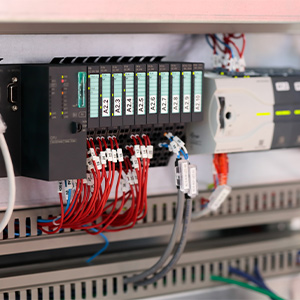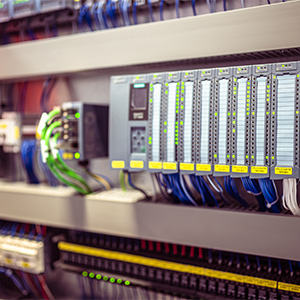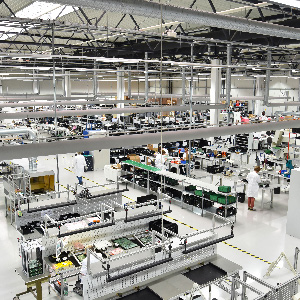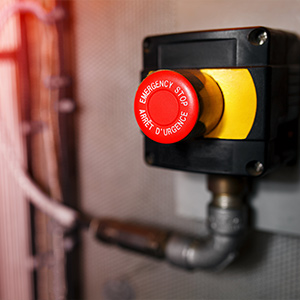Machine safety is an umbrella term embracing several aspects of machine operation. It applies to machinery in use in any field of productivity which might pose a threat to human life or health. Machine safety means applying safeguards not only to the machinery itself, but also to the human beings who work with them. The health of the human operators is paramount, and the safety of a machine includes its proper running so that operation doesn't add further risks of dangerous failure.
Some common examples of machine safeguards are physical barriers covering moving gears or blades and interlocks to stop a machine if anyone gets too close to it. It's important to prevent people from wandering into hazardous areas by accident, which is where safety light fences and sensors come in. PPE such as goggles and protective clothing are also vital to worker safety, and can guard them against potential hazards.
Why Is Machine Safety Important?
Surveys of the manufacturing industries report a yearly average of 22 deaths due to workplace accidents, plus over 3,100 major injuries and 4,100 or so injuries requiring a week or more of recovery time. An additional 33,000 workers are suffering ill-health as a result of some exposure to hazardous situations or substances encountered at work. Some of these develop long-term and even fatal diseases.
Manufacturers cannot afford to sustain this level of damage, which affects not only their bottom line, but also their reputation as an employer with a bad safety record. For this reason, more attention is being devoted to building in safety features to the machines themselves. A range of standards are rigidly applied to ensure that the build of new machines incorporates as many safety features as possible – and that these comply with the parameters set by the standards institution to ensure maximum safety.
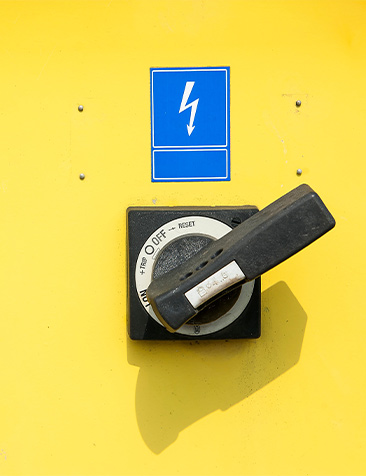
Safety Components For Machines
When commissioning and installing machinery, there are several different components that should be considered, according to your set-up and circumstances.
Safety Switches
Safety switches represent the first link in an electrical chain of operational safety, detecting signals that are then safely forwarded for evaluation. Once detected, the signals are processed by basic or programmable safety relays, safety PLCs or fail-safe safety controllers. The primary function of safety switches is to protect against electric shocks: if a current leak is detected, they almost instantaneously cut off the electricity supply.
Safety switches are used to monitor the electric current in many types of application, from equipment like conveyor belts and heavy appliances to an entire system. They cover an array of different types and functions, including position switches with actuators, hinges, or tumblers for detecting door movements, and electromagnetic or spring-lock models. Safety switches also come as keys that detect a moving machine guard's position, situated on the leading edges of lift-off, sliding or hinged guards.
Safety Relays
Safety relays are the particular type of relay used in building safety circuits. They come in many different shapes and sizes and are used for many different purposes, including domestic, military and commercial. They're designed to meet the requirements for the safety-related functions of a control system and are categorised into various safety levels. For example, the universal safety relay can be used with almost all safety devices, and typically offer either preset parameters or a custom configuration. This type of safety relay provides you with comprehensive status information, error messaging, and precise timer functions.
Safety relays used to be discrete circuits linked individually to each equipment function, such as emergency stops and safeguard controls. Most modern safety relays are now designed as compact modular units, which offer more flexibility on top of the basic safety functions. Their modular design offers increased efficiency in a simple package, with built-in capacity for advanced system planning and expansion. There is no need for each function to be individually hard-wired and they can be installed in a control panel or DIN rail.
Emergency Stops
Emergency stops are the big red buttons that you push when you want to stop a machine in a hurry. They are usually mushroom-shaped for ease of action, and may have Stop or Emergency inscribed on them. If something is going wrong with the workflow, or there's a risk of someone getting injured, that's when you hit the Stop button. Also known as an E-Stop, this fail-safe control switch keeps both the machine and its operator safe by means of a circuit breaker that cuts off the power supply.
You might find machines with more than one emergency stop button if it has several active components. Apart from industrial environments, you'll find these buttons in lifts, on escalators, and on lifting equipment. These highly visible buttons are designed to specific standards and must be self-holding, so that they can't accidentally release and set the machine in motion again. To release the button you'll have to pull it back, twist it, or use a key if the circuit is secured.
Safety Light Curtains
The function of a safety light curtain is to stop a hazardous machine process if anyone gets too close to it. It consists of a photoelectric transmitter and a receiver unit, which pass infrared light beams across a designated access space. If any opaque object – such as a person – interrupts the beams within the sensory field, the light curtain's control logic will instantly transmit a stop signal to the machine. The parameters of the light curtain's activity are controlled by an integral safety control circuit.
This kind of safety circuit is installed at a chosen distance so that when the light beam is broken, the machine has time to come to a full halt. You can use a video feed to monitor the stop times of your light curtain in order to check whether it's effective enough. You might find you have to move the light curtain further away for it to provide a safe stopping distance, or you might have to raise or lower the top and bottom beams to cover the maximum penetrable area. You'll also need to ensure that there are no gaps where people can reach around or under the light beams.
Today's light curtains can be fine-tuned for maximum safety control. This tuning includes the muting or temporary automatic suspension of their activity so that particular discrete items can pass through them. You'll also need to evaluate the needs and performance of your guarded machinery to make sure light curtain protection is appropriate. Machinery that throws out flying debris, for example, such as a grinder, is not suitable for this kind of safety circuit.
Safety Controllers
Safety Controllers combine the standard PLC with dedicated safety programs, providing fail-safe operation for any equipment or applications where heightened protection is required. The same CPU can handle the standard operating tasks while simultaneously running a dedicated safety system. Compact safety controllers can also be added to existing architectures and integrated with communications functionality. Since their safety functions are not hard-wired but based on software, safety controllers can be more easily modified, reproduced or expanded. Such units are being used in many of today's industrial applications, and they can also be custom-built in any sector to encompass individual system requirements.
>Safety PLCs
Automated industrial plant and equipment is frequently now run by programmable logic controllers (PLCs). Safety PLCs support the same range of applications as a standard PLC, but they add some specifically designed and integrated features to control dedicated safety-related systems. They have built-in redundant microprocessors which stand by as a backup, to prevent system failure or to ensure that an inevitable failure is safe. Their own diagnostic features continuously monitor what's going on with its various inputs and outputs. If any internal failure or fault is detected, the PLC will shut down safely.
Safety PLCs are much more flexible than standard PLCs. They don't require field wiring of multiple safety relays, thereby saving both time and money. They can easily be reprogrammed, and password-protected to prevent unauthorised access after they've been tested and validated. Safety PLCs are also capable of much more complex integrated operations, such as controlling the safe operation of variable speed drives and a multiplicity of I/O feeds.
Choosing Safety Components
From this overview, you can see how important it is to choose the right safety components. If you're running a small legacy system with only one or two basic processes, then safety relays and switches will probably still work for you, with the necessary inclusion of an Emergency Stop. For larger and more complex systems, and areas where human activity is frequent, a safety light curtain might be a good choice, unless you're in the machine tools business where there's a possibility of debris.
Most larger enterprises in 21st-century manufacturing are integrating safety controllers into their existing systems or installing new safety PLCs. The initial cost of these more complex solutions is higher, but in the long run more cost-effective for large-scale production.

